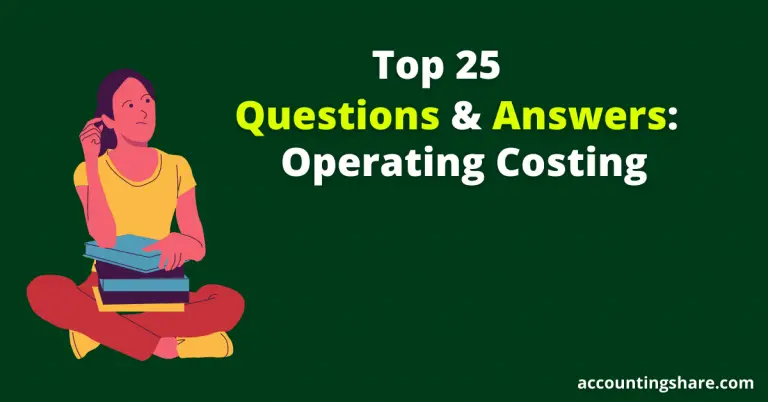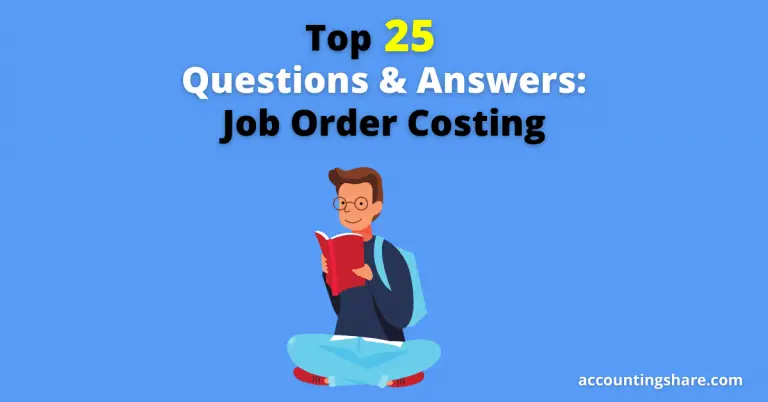Top 30 Questions and Answers-Process Costing [With PDF]
Here, we’ll learn the Top 30 Questions and Answers-Process Costing. It will undoubtedly assist you in gaining a basic understanding of process costing as well as assisting you in passing any competitive test.
So let’s get started.
Questions and Answers-Process Costing
Question-01: What does the process costing mean?
Answer: The method of calculating the total cost of production by calculating the cost of different processes separately is called process costing.
Question-02: In what types of industries use the process costing method?
Answer: Industries like chemicals, textiles, food, Steel, Sugar, Shoes, Petrol, etc. use the Process Costing method.
Question-03: What are the features of process costing?
Answer: The features of process costing are as follows:
- Process costs are appropriate for industries that manufacture homogeneous products.
- The output of one process is used as raw material by another process.
- Calculate output in terms of equivalent units.
Question-04: What are the advantages of process costing?
Answer: The advantages of process costing are as follows:
- Process costing is a simple and straightforward form of cost assessment.
- In order to ascertain correct costs, it is easy to assign the expenditures to processes.
- It reduces the amount of data and makes the process of data collection simple and quick.
Question-05: What are the limitations of process costing?
Answer: The limitations of process costing are as follows:
- The cost of each process is just historical costs, which might not be very helpful for efficient control.
- Since work-in-process is normally performed on an approximate basis, total cost estimates can result in inaccuracy.
Question-06: What is the distinction between Job order costing and Process Costing?
Answer: The distinction between Job order costing and Process Costing is as follows:
- Job order costing is performed against particular order placed by customers, while continuous production is performed in the case of process costing.
- For unique products, job order costing is used, while for standardized products, process costing is used
Question-07: What are the five steps of process costing?
Answer: The five steps of process costing are as follows:
- Summarize the physical unit’s flow.
- Calculate output in terms of equivalent units.
- Summarize the overall expenses to account for.
- Cost calculations per equivalent unit.
- Assign cumulative costs to units completed and to units in ending work in process.
Question-08: What is parallel process costing?
Answer: When each process produces a product independently of the other and the product of one is not used as a raw material in the next process it is basically called a parallel process. The calculation of cost in this method is called parallel process costing.
Question-09: What is sequential process costing?
Answer: If more than one process is required in the production of a product and the final product of the first process is used as the raw material of the next process, then those processes are called sequential process and the cost calculation in this method is called sequential process costing.
Question-10: What is selective process costing?
Answer: Joint products may be processed differently or maybe sold without processing. This process of production is called the selective process. The calculation of cost in this method is called selective process costing.
Question-11: What are the elements of process costing?
Answer: The elements of process costing are as follows:
- Direct Material
- Direct Labor
- Direct & Indirect Expenses
Question-12: What is normal loss?
Answer: The loss that cannot be avoided despite taking all kinds of precautions during production and the loss that will occur due to the process of production is called normal loss.
Question-13: How is normal loss calculated?
Answer: The amount of normal loss is calculated at a pre-determined rate based on the goods used in the factory. In many cases, normal losses are also calculated on the products produced at a fixed rate.
Question-14: What is abnormal loss?
Answer: If the actual loss in a process is greater than the normal loss, then that additional loss is called abnormal loss.
Question-15: What is abnormal gain/profit?
Answer: When the actual loss is less than the normal loss, the actual production is higher than the normal production. Such excess production is called abnormal gain/profit.
Question-16: What is wastage?
Answer: If any raw material is wasted during production and cannot be reused later, then that raw material is called wastage.
Question-17: What is spoilage?
Answer: When the raw material is wasted during the production process in such a way that the raw material can no longer be used in the subsequent process, or can be used without modification, it is sold at a lower price without transferring it to the next process is called spoilage.
Question-18: What is scrap?
Answer: The remnants of raw materials that are sold at low prices are called scrap. For example, an oil tin manufacturer sells its leftover raw materials to a toy manufacturer. Such raw materials are scrap.
Question-19: What is a defective product?
Answer: If the product is not up to standard, it is called a defective product. In some cases, due to the lack of perfection of raw materials, labour, machinery, etc. for the production, the product produced is not correct and is defective.
Question-20: How many types of accounting treatment of normal loss in process costing are there?
Answer: There are 2 types of accounting treatment of normal loss in process costing which are as follows:
- Less Correct Method and
- More Correct Method.
Question-21: What is input?
Answer: The material that is inserted in a process is called input. The amount of output depends on this input
Question-22: What is the output?
Answer: Output refers to the number of goods produced in a process.
Question-23: What is equivalent Production?
Answer: The main feature of the production process is that there will be some unfinished work / ongoing work at the end of a certain period of time. Converting this unfinished/current functional unit to the finished product is called equivalent production.
Question-24: What are the types of work in process?
Answer: There are two types of work in process which are as follows:
- Opening work in process
- Closing work in process
Question-25: What is inter-process profit?
Answer: In order to verify the efficiency of the process, a certain amount of profit is added to the production cost of the product produced in the previous process and sent to the next process. Such profit is called inter-process profit.
Question-26: What is unrealized profit?
Answer: If the part of the product is unsold after transferring the product with profit from one process to another, the amount of profit-taking on the unsold product is called unrealized profit.
Question-27: What are the causes of loss?
Answer: The causes of loss are as follows:
- Defective raw materials
- Unskilled workers
- Unplanned production system
- Accidental accident, etc.
Question-28: What are the causes of wastage?
Answer: The causes of wastage are as follows:
- Evaporation
- Contraction
- Smoking etc.
Question-29: What does the cost of production report mean?
Answer: A report that is prepared over a specific period of time showing details of process cost information is called a cost of production report.
Question-30: The production cost report can be divided into how many parts and what are they?
Answer: The Production cost report can be divided into 2 parts which are as follows:
- Part of the production Volume and
- Part of the production cost.
You can also read:
Top Questions and Answers:








Nice questions with good answers and we also request you to post the calculation part of process costing